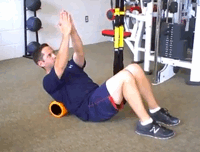Thoracic spine mobility is an extremely important, and often times overlooked, component to a variety of dysfunctions. Poor thoracic mobility can affect the shoulder, neck, low back, and hip very easily. Unfortunately, our daily habits and posture make us all very prone to poor thoracic spine mobility.
I have talked about this before when discussing my reverse posturing theory and when discussing what may be the best posture stretch that I know. A key component to reverse posturing is working on thoracic spine mobility.
There are many variations of thoracic spine mobility exercises and drills out there on the internet. Many of them are great, but not for everyone. Here is a collection of thoracic spine mobility exercises that you can try with your patients and clients. These are all great example, but at the end I will discuss my preferred technique and a simple thoracic spine mobility exercises that is easy for everyone to perform. I think it is a great place to start when trying to enhance thoracic spine mobility.
Regardless of which thoracic mobility exercise you chose, there is one major goal that MUST be achieved during all of the different mobility drills:
[box type=”info” size=”large”]Mobility must come from the thoracic spine and NOT the lumbar spine[/box]
This is critical and the easiest way to turn a nice corrective exercise for the thoracic spine into a mobility drill for the lumbar spine that feeds into the person’s deficiencies.
Thoracic Spine Mobility Exercises for Extension
We should start with thoracic spine mobility exercises that work on increasing thoracic spine extension. Here are a couple of nice examples.
Thoracic Spine Mobility Exercise for Extension Using Tennis Balls
Here is a nice example of a simple extension mobilization for the thoracic spine. In this video, Michael Boyle shows us how he uses two tennis balls to act as a pivot to thoracic extension:
Nice simple exercise that works on addressing the lack of thoracic spine exercise. The tennis balls are positioned at various spine segments. A good place to start for many people.
Thoracic Spine Mobility Exercise for Extension Against a Wall
Another nice drill that emphasizes thoracic extension can be performed against a wall. Bill Hartman demonstrates this well:
http://www.youtube.com/watch?v=H5zmkW5EO6s&feature=related
This is another great option for many people, though may be challenging for someone with tight lats, shoulder issues, or really large restrictions in thoracic mobility.
Thoracic Spine Mobility Exercises for Rotation
After we work on thoracic spine extension, we can also focus on thoracic spine rotation mobility. Here are a couple of examples of good thoracic spine mobility exercises to enhance rotation.
Thoracic Spine Mobility Exercises for Rotation in the Seated Position
A simple thoracic mobility drill for rotation can be performed in the seated position. Here is a nice demonstration by Jeff Cubos:
As you can see, the person is squeezing something between her knees in the seated position. This is intended to help engage the core and limit the amount of lumbar stability. This seems really simple but the majority of people with poor thoracic mobility will perform this poorly and rotate from the lumbar spine. This one really needs to be coached and cued well to assure that technique is perfect, otherwise you will be working the wrong area! You can see that she does a good job rotating at the thoracic spine with just a small movement, but as we all know, more is usually better in many people’s minds. Be careful that they don’t go home and just torque their lumbar spine.
Here is another seated drill by Michael Boyle that incorporates rotation and extension:
Thoracic Spine Mobility Exercises for Rotation in the Quadruped Position
A very common and popular thoracic spine mobility drill right now on the internet is in the quadruped position. The quadruped position is used to put the hips in a degree if flexion to minimize the amount of lumbar spine movement. Here is a great example from Eric Cressey:
Eric does a good job showing his technique. Lucky for us as the viewer you can see that Eric has some mobility issues that he is working on. This is a good exercise but challenging for some people to get into the position due to lack of hip flexion mobility. Realistically the quadruped position is unachievable by some people. As you can see in Eric’s video, his hip flexion mobility isn’t great, so his hip flexion angle is not as much as it could be and subsequently he can get too much lumbar spine rotation. This is a great exercise and Eric demonstrates it well. This can be used in more advanced situations with people that have proper hip mobility and no concerns in the quadruped position.
A Simple Program to Work on Both Thoracic Spine Extension and Rotation
My preferred technique for thoracic spine mobility exercises is actually pretty simple. I use a foam roll to quickly combine three different drills into one quick program that is in an easily achievable position for many people:
First, I start off with simple foam rolling of the thoracic spine. I like to start with foam rolling to loosen up the soft tissue of the thoracic spine and reduce and potential spasm or muscle tightness that might limit my joint mobility. My hands are positioned across my chest to protract and clear my scapulas to allow access to my paraspinals. This video is a quick demonstration but I take my time with this and usually roll back and forth for about a minute, spending time on whatever area feels the tightest that day.
Next, I will work on extension mobility. When the thoracic spine is in a flexed position, it is going to be very difficult to achieve rotation, so I want to work on extension first so that my upcoming rotational drills are more effective. In the video, I demonstrate a technique very similar to Michael Boyle above. I roll up and down the thoracic spine and try to stop at each vertebral segment and perform a few extension mobilizations. The foam roll acts as a fulcrum, my lower half (lumbar spine) is stable, and my upper half pivots at the foam roll. This applies a very specific thoracic spine mobilization that you can focus on individual spine levels. I will roll up and down about an inch at a time and then work on extension. Again, the video is a quick demonstration, I will do about 10 extension movements at each segment, but will focus on specific levels as needed.
Lastly, now that we have loosened up the muscles and increased thoracic spine extension, we can work towards increasing rotation. I again just simply use a foam roll in the same position on the ground. This allows for a quick progression of drills that you can bang out in sequence with ease. Similar to the extension mobility drill, I use the foam roll as a fulcrum. Again, my lower half is stable and my upper half pivots into thoracic rotation at the point of contact of the foam roll, allowing for a specific mobilization at the level of your choice. I prefer to extend my hands up in front of my face. I feel that this helps my visualize the amount of rotation achieved. I instruct people to just rotate your hands one hour on the clock to help them visualize the small amount of movement. Otherwise, if you are rotating more than that, you are compensating somewhere, likely with lumbar rotation below the fulcrum of the foam roll. As your mobility improves you can try to focus on rotating and adding a small extension component, similar to Michael Boyle’s drill above.
This series of thoracic spine mobility exercises are usually where I begin with people. As mobility increases, I use many of the other exercises demonstrated above based on the person’s individual deficits and goals. There are a lot of options when performing thoracic spine mobility exercises, what else have you found to be effective?






